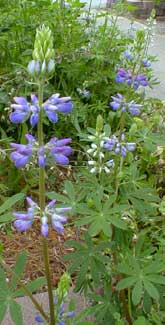
Wild Sundial Lupine
"Die as some Greek dog-sage, dead & merry,
Hellward bound in Charon's wherry,
With food for both worlds, under & upper,
Lupine-seed & Hecate's supper."
-Robert Browning
(1812-1889)
(1812-1889)
Large cultivated hybrid lupines have always struck me as gaudy, tippy, rather foolish flowers with a horrible texture if you rub up against one or touch it, plus a tendency to attract aphids. But the smaller looser upright spires of pea-flowers on wild sundial lupines (Lupinus perennis) are sufficiently subdued & naturalistic that they are immediately more tasteful, less inclined to tipping, with smaller tidier umbrella-leaves, & less apt to be covered with aphids. This wildflower is all-round more appealing than the pumped-up cultivars.
A wildflower native to most of the eastern half of North America, these ended up along our roadside from a packet of wildflower seeds. The wisdom of including east-coast lupines in generic wildflower mixes to unleash in the Pacific Northwest, which has its own lupine species, should probably be questioned, as it will hybridize with other species of lupines outside its natural range, hence a potential threat to region-appropriate natives. Though to tell the truth, it is the basic blue L. perennis that is most threatened due to crossbreeding with the widely gardened L. polyphyllus changing the nature of the Sundial Lupine in its natural range.
As with most plants with a wide natural range, Sundial Lupine has a number of folk names including Blue Bean, Quaker's Bonnet, Old Maid's Bonnet, Texas Blue Bonnet, Indian Beat (because of the deep root), & Perennial Lupine. This forb has a deep taproot that makes it exceedingly drought-hardy, so it does well in poor sandy soil that drains well & is not irrigated, in full sun.
Due to the taproot, they are not easily transplanted, but are very easily started from seed. To maximize germination, cold-soak the seeds overnight then sew into loosened soil in spring.
In rainy zones such as here on Puget Sound, it is less at risk of rotting out of a garden than are hybrid lupines, even though ideally it has a dry location. It can be grown among xeriscape herbs such as sages or rockroses, or in open meadows. It usually blooms its second year in the ground, occasionally not until its third year, but thereafter it blooms every year from an expanding two-foot-tall clump. The flowers are at their peak in May & June, & are liked by butterflies, bees, & hummingbirds.
An old belief that lupines deplete the mineral content of soil is untrue. Lupine means "wolf" & it was so named because of the false belief that it depletes or "wolfs" soil. The reality is that it fixes atmospheric nitrogen to the soil, as do all pea-family forbs, making nitrogen more available to its fellow meadow plants.
It should not be planted around livestock because the seeds (beans) & mature stems of lupines are potentially toxic to ruminants, causing lupinosis especially in sheep, the effects of which range from drunkenness to death. It is nevertheless grazed by deer without ill effect, & has been planted in some countries specifically as a grazable crop. This contradiction is due to the fact that not all lupine populations are toxic; only lupines exposed to the fungus Diaporthe toxica produce toxic alkaloids sufficient to cause lupinosis in sheep. Cattle are far less effected, but gestating cattle that eat much lupine may have calves with birth defects.
Lupine is otherwise a bitter but potentially edible plant, & the beans if thorougly leeched by soaking the beans & discarding the water, then well cooked to remove & break down the potential toxicity, have served as a famine food or wild delicacy.